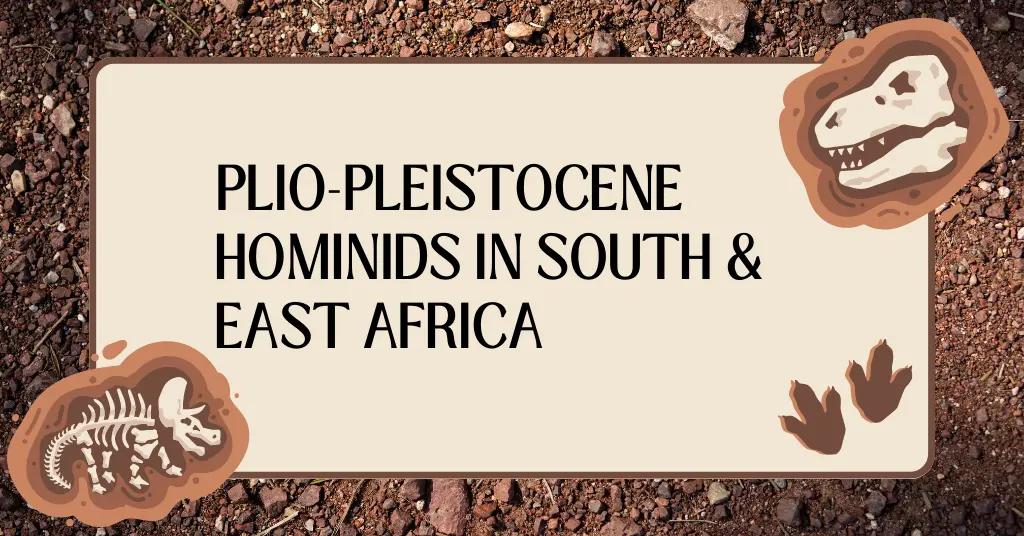AI Answer Evaluation Platform Live Now. Try Free Answer Evaluation Now
Plio-Pleistocene Hominids in South and East Africa
Understanding the journey of human evolution is a captivating quest, involving an array of scientific disciplines. The story of our ancestors traces back to Africa, where hominids, our distant relatives, first appeared. The Plio-Pleistocene epoch (5.3 million to 11,700 years ago) was a significant era for hominid evolution, particularly in South and East Africa. This article delves into the Plio-Pleistocene hominids found in these regions, exploring their origin, unique features, and the role they played in shaping the human lineage.

South and East Africa: A Cradle of Human Evolution
South and East Africa have been pivotal in our understanding of human evolution due to the abundance of fossil records [1]. Some of the most iconic Plio-Pleistocene hominids fossils have been discovered in regions such as the Great Rift Valley, Olduvai Gorge, and Sterkfontein.
- Great Rift Valley: Spanning from Lebanon to Mozambique, this region is most famous for the discovery of “Lucy” (Australopithecus afarensis), found in the Afar Triangle of Ethiopia. The rich fossil sites have produced remains of several hominid species dating from the Plio-Pleistocene epoch.
- Olduvai Gorge: Located in Tanzania, Olduvai Gorge has yielded fossils and stone tools of early hominids like Homo habilis, strengthening our understanding of early human life.
- Sterkfontein: The South African site is known for “Mrs. Ples” (Australopithecus africanus) and “Little Foot” (likely Australopithecus prometheus), providing insights into hominid cranial and postcranial anatomy [2].
Key Plio-Pleistocene Hominids
Plio-Pleistocene epoch is distinguished by the emergence of various hominid species. Some key hominids discovered in South and East Africa during this period are:
1. Australopithecus
Australopithecus, meaning ‘southern ape’, is a genus that lived between 4.2 to 1.9 million years ago. They are characterized by their bipedal locomotion and small brain size relative to body size.
Notable Species:
- Australopithecus afarensis: Famed for the specimen ‘Lucy’, it shows significant evidence of bipedalism [3].
- Australopithecus africanus: Discovered in Sterkfontein, South Africa, it shares similarities with both apes and humans [4].
2. Paranthropus
Paranthropus is a robust genus known for its large teeth and strong jaw muscles, adaptations for a diet of tough vegetation. They existed between 2.7 to 1.1 million years ago.
Notable Species:
- Paranthropus boisei: Found in East Africa, it is characterized by a ‘dish-faced’ facial appearance [5].
- Paranthropus robustus: Discovered in South Africa, it demonstrates similar robust features [6].
3. Homo
The Homo genus, to which modern humans belong, appeared around 2.5 million years ago and is distinguished by a larger brain and tool-making capabilities.
Notable Species:
- Homo habilis: Known as ‘handy man’ due to its association with stone tools [7].
- Homo erectus: This species displays evidence of a more human-like body proportion and is associated with advanced stone tools [8].
Table 1 below summarises the features of these hominid genera.
| Genus | Key Features | Notable Species |
|---|---|---|
| Australopithecus | Bipedal, small brain relative to body size | A. afarensis, A. africanus |
| Paranthropus | Large teeth, strong jaw, diet of tough vegetation | P. boisei, P. robustus |
| Homo | Larger brain, tool-making capability | H. habilis, H. erectus |
Significance and Impact
Uncovering these hominid fossils has significantly shaped our understanding of human evolution. It has provided evidence supporting theories such as bipedalism as a key human trait, the role of climate change in hominid evolution, and the ‘Out of Africa’ theory [9]. Importantly, it continues to offer new discoveries that challenge and refine our understanding of our ancestral past.
Paleoclimatic Context and Its Implications
The Plio-Pleistocene period was characterized by significant climatic changes, with a gradual cooling trend and increased climatic variability [10]. These shifts in climate played a crucial role in hominid evolution. The environmental change led to shifts in vegetation and subsequently, changes in diet and foraging behavior among hominids.
- Emergence of Savannas: The gradual replacement of forests by open savannas led to increased bipedalism, a defining characteristic of hominids [11]. Walking on two legs was more energy-efficient in these new environments, facilitating longer-distance travel in search of food.
- Dietary Shifts: The shift to a more varied and unpredictable food supply may have led to increased brain size, particularly in the genus Homo. These hominids could adapt their diets and devise new ways to obtain food, which likely stimulated cognitive development [12].
Tools and Technology
The emergence of tool technology marks a significant step in hominid evolution. Hominids began to alter their environment to their advantage, signaling a shift towards the behavior of modern humans.
1. Oldowan Tools
The oldest known stone tools, termed Oldowan, are associated with Homo habilis from about 2.6 million years ago. These tools are simple and primarily used for breaking open bones or cutting [13].
2. Acheulean Tools
Acheulean tools, associated with Homo erectus, appear around 1.7 million years ago. They are more advanced than Oldowan tools, showing evidence of forethought and planning in their creation [14].
Diverse Evolutionary Pathways
The Plio-Pleistocene epoch saw a diversification in hominid species, an aspect that’s both fascinating and challenging to our understanding of human evolution. This diversification, sometimes referred to as the “hominid bush,” suggests multiple evolutionary experiments were underway [15].
1. Paranthropus: An Evolutionary Experiment?
Paranthropus, with its specialized cranial and dental features, represents a unique adaptive strategy that ultimately became extinct. The exact reasons for this extinction remain uncertain, but likely involve climatic changes and competition with Homo species [16].
2. Homo: The Successful Lineage
In contrast, the genus Homo, while beginning with relatively modest brain sizes, shows a trend towards increased cranial capacity over time. The Homo lineage’s adaptability, demonstrated by its tool use and variable diet, likely contributed to its evolutionary success [17].
Conclusion
The journey of human evolution is a complex tapestry of interconnected species and environments. The Plio-Pleistocene epoch in South and East Africa is a vibrant chapter of this story, housing a rich array of hominid fossils that provide unique insights into our shared past. As technology and methods improve, our understanding of these hominids continues to evolve, promising exciting new revelations about our origins.
References
[1] Klein, R. (2009). The Human Career: Human Biological and Cultural Origins. University of Chicago Press.
[2] Grine, F. E., et al. (2012). “Evidence for cranial endocast deformation in Homo habilis and Australopithecus afarensis”. Journal of Human Evolution.
[3] Lovejoy, C. O. (2005). “The natural history of human gait and posture Part 1. Spine and pelvis”. Gait & Posture.
[4] Dart, R. (1925). “Australopithecus africanus: The Man-Ape of South Africa”. Nature.
[5] Wood, B., et al. (1991). “Paranthropus boisei: Fifty years of evidence and analysis”. American Journal of Physical Anthropology.
[6] Grine, F. E. (1988). “Evolutionary history of the “robust” australopithecines”. American Anthropologist.
[7] Leakey, L. S. (1964). “A new species of the genus Homo from Olduvai Gorge”. Nature.
[8] Antón, S. C. (2003). “Natural history of Homo erectus”. American Journal of Physical Anthropology.
[9] Stringer, C. (2012). “Lone Survivors: How We Came to Be the Only Humans on Earth”. Times Books.
[10] deMenocal, P. B. (2004). “African climate change and faunal evolution during the Pliocene-Pleistocene”. Earth and Planetary Science Letters.
[11] Lovejoy, C. O. (1981). “The origin of man”. Science.
[12] Aiello, L. C., & Wheeler, P. (1995). “The Expensive-Tissue Hypothesis”. Current Anthropology.
[13] Semaw, S. (2000). “The World’s Oldest Stone Artefacts from Gona, Ethiopia”. Nature.
[14] Lepre, C. J., et al. (2011). “An earlier origin for the Acheulian”. Nature.
[15] Wood, B., & Collard, M. (1999). “The Human Genus”. Science.
[16] Grine, F. E. (1988). “Evolutionary History of the “Robust” Australopithecines”. American Anthropologist.
[17] Antón, S. C., Potts, R., & Aiello, L. C. (2014). “Evolution of early Homo: An integrated biological perspective”. Science.



